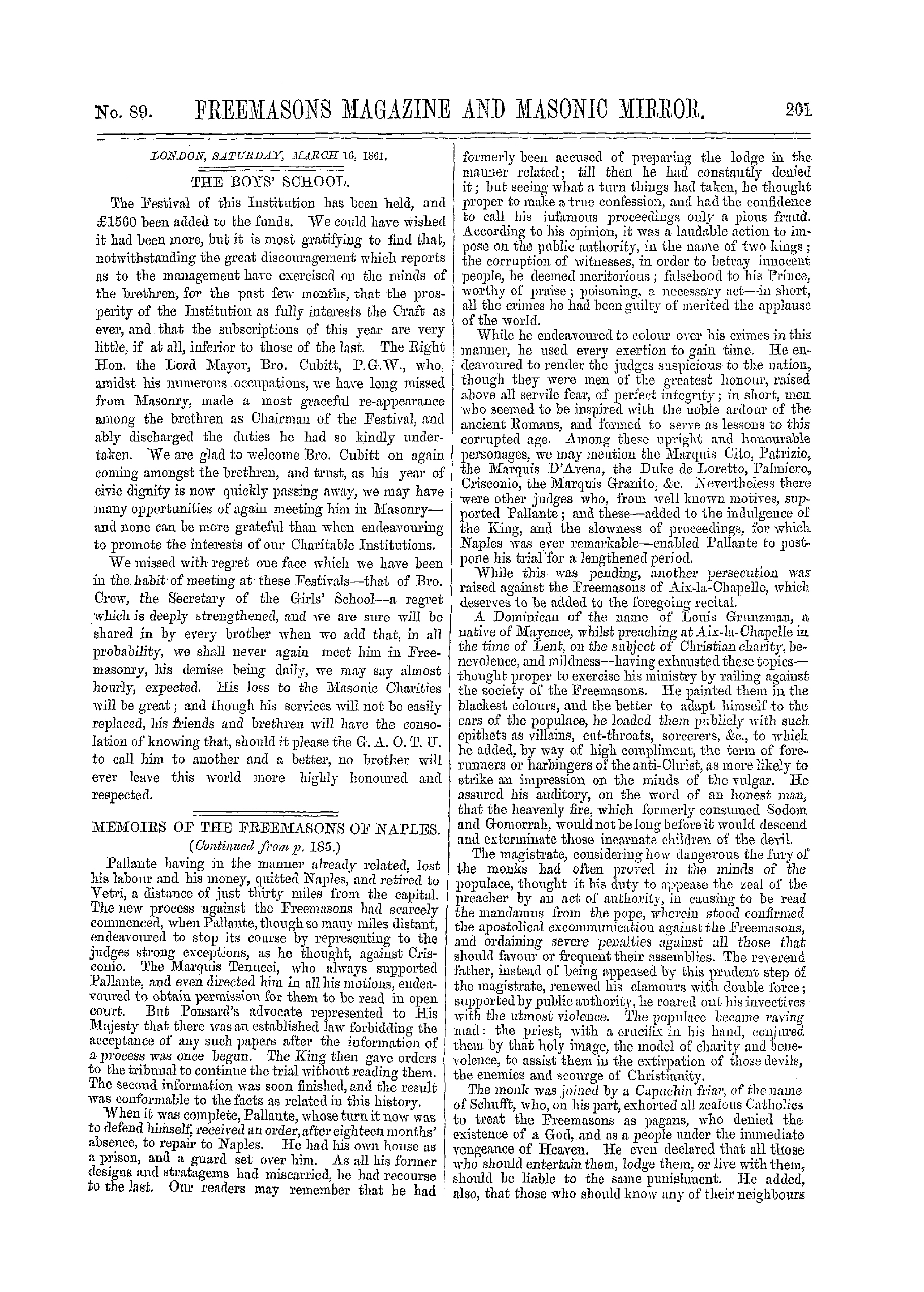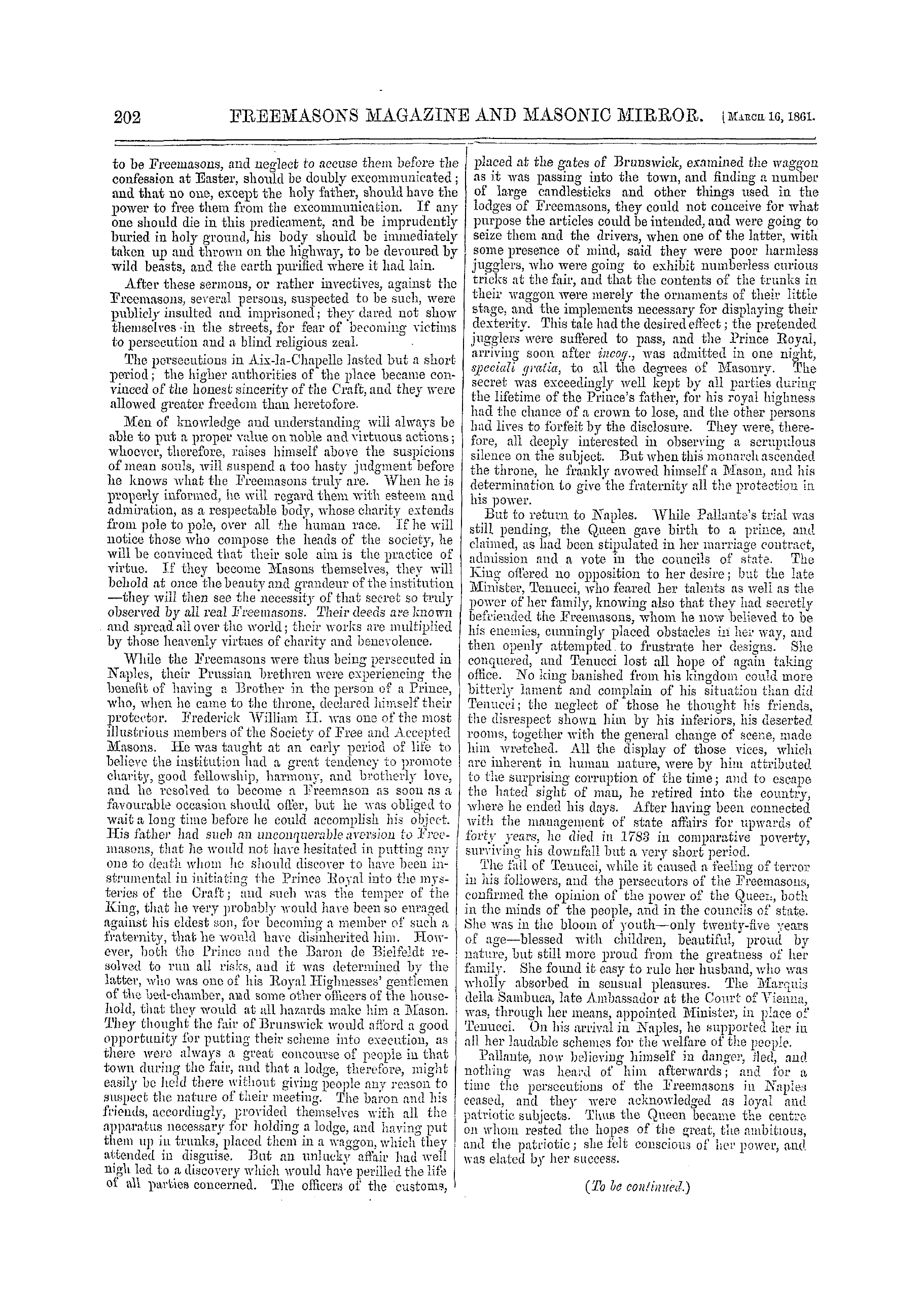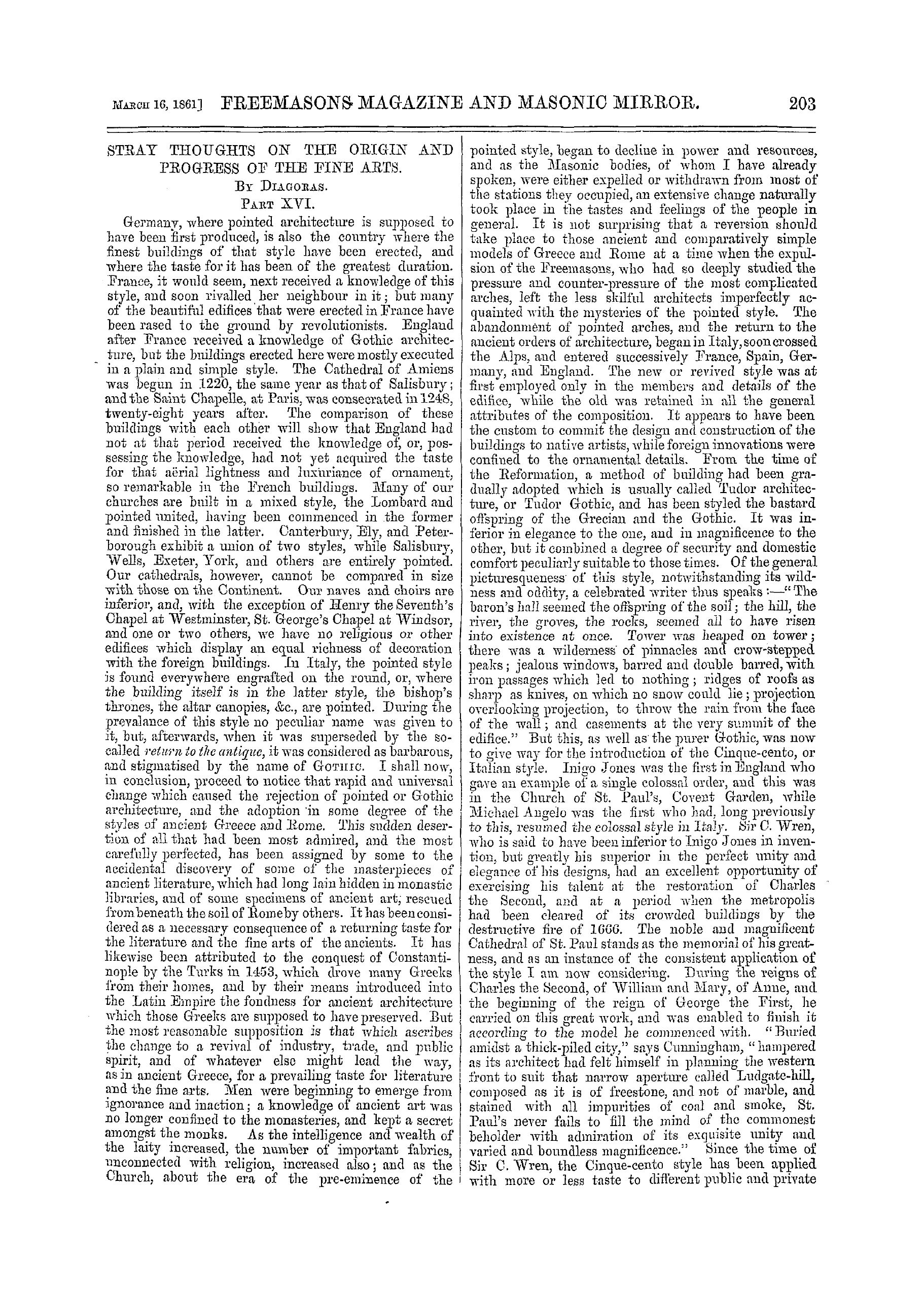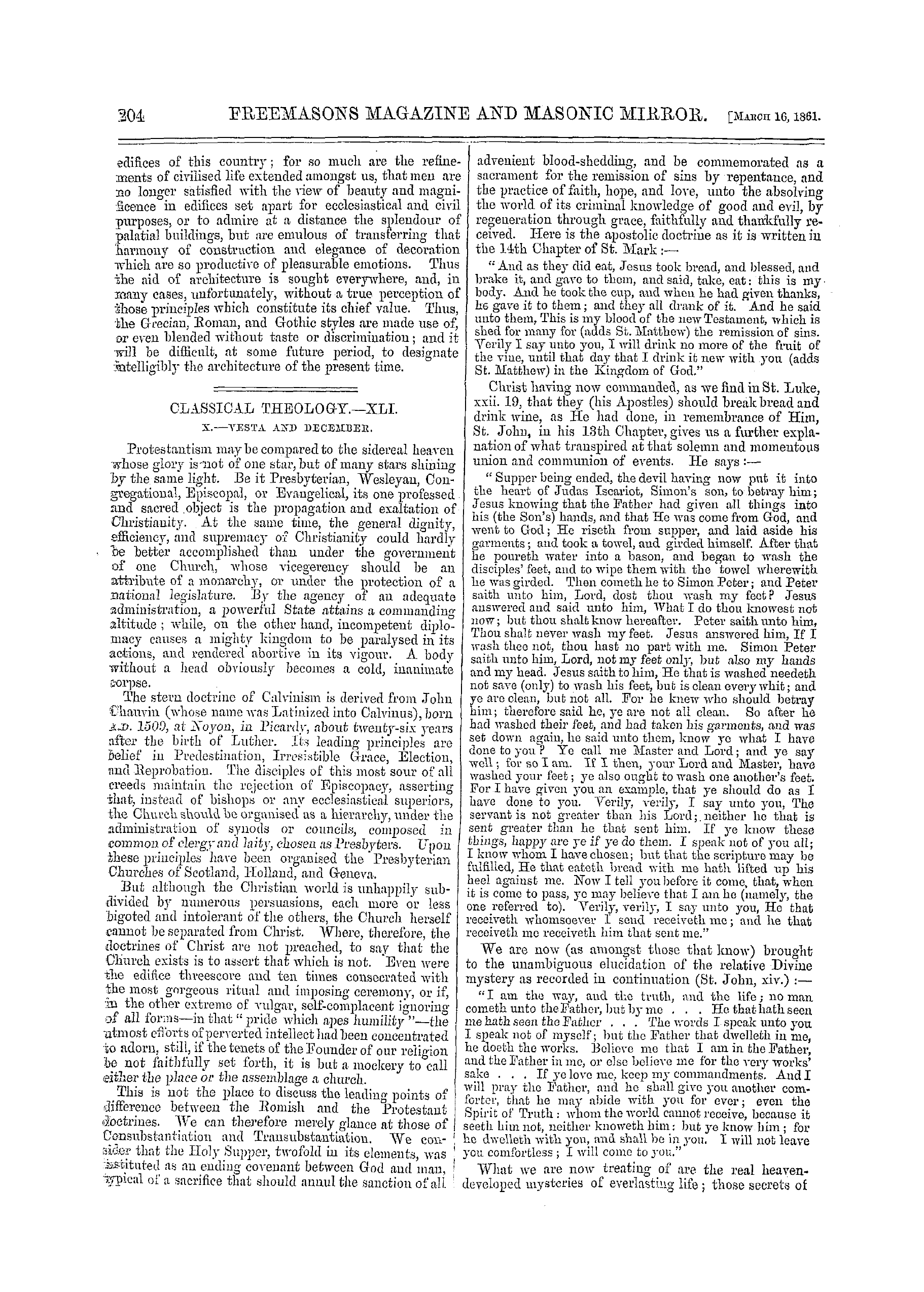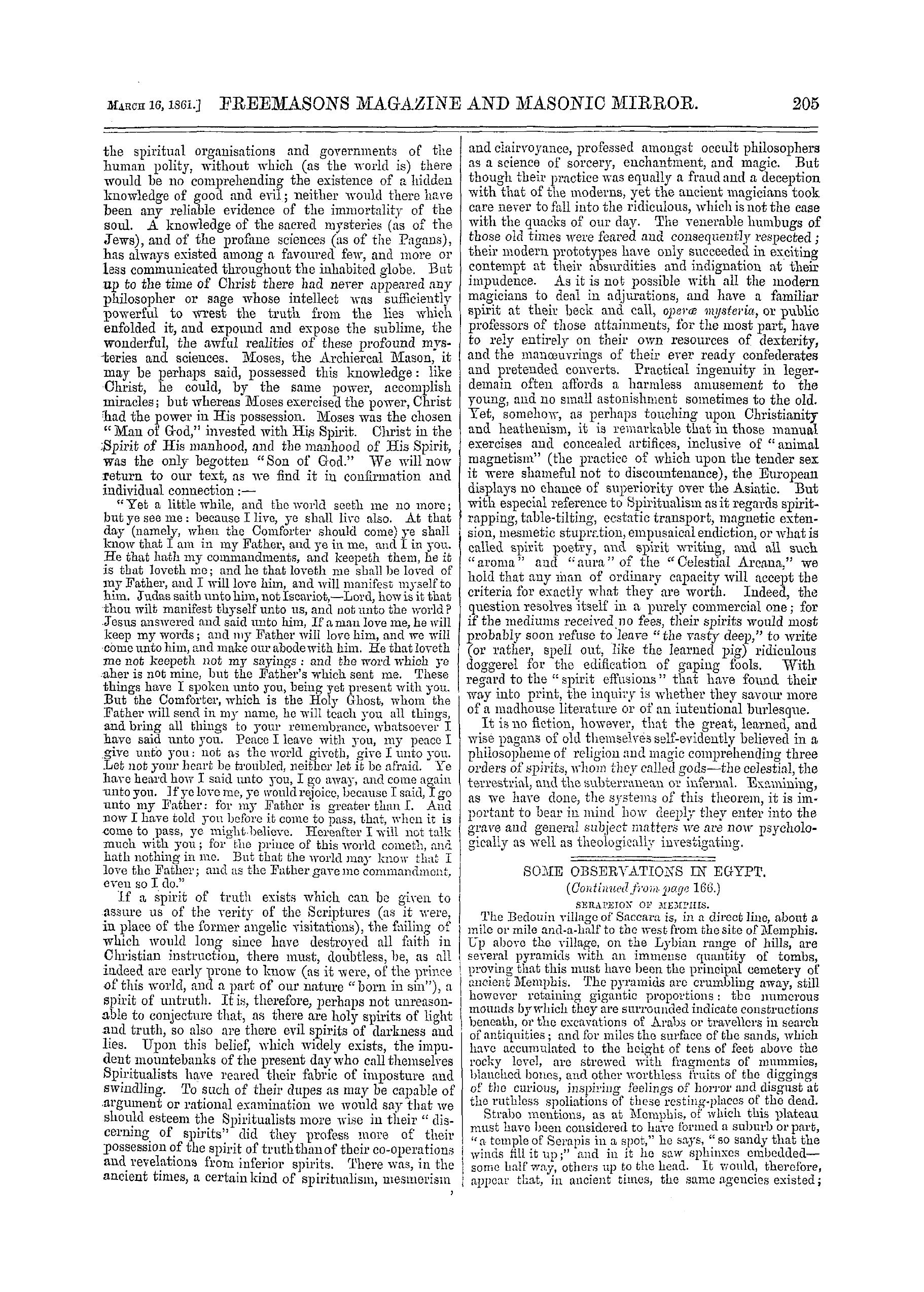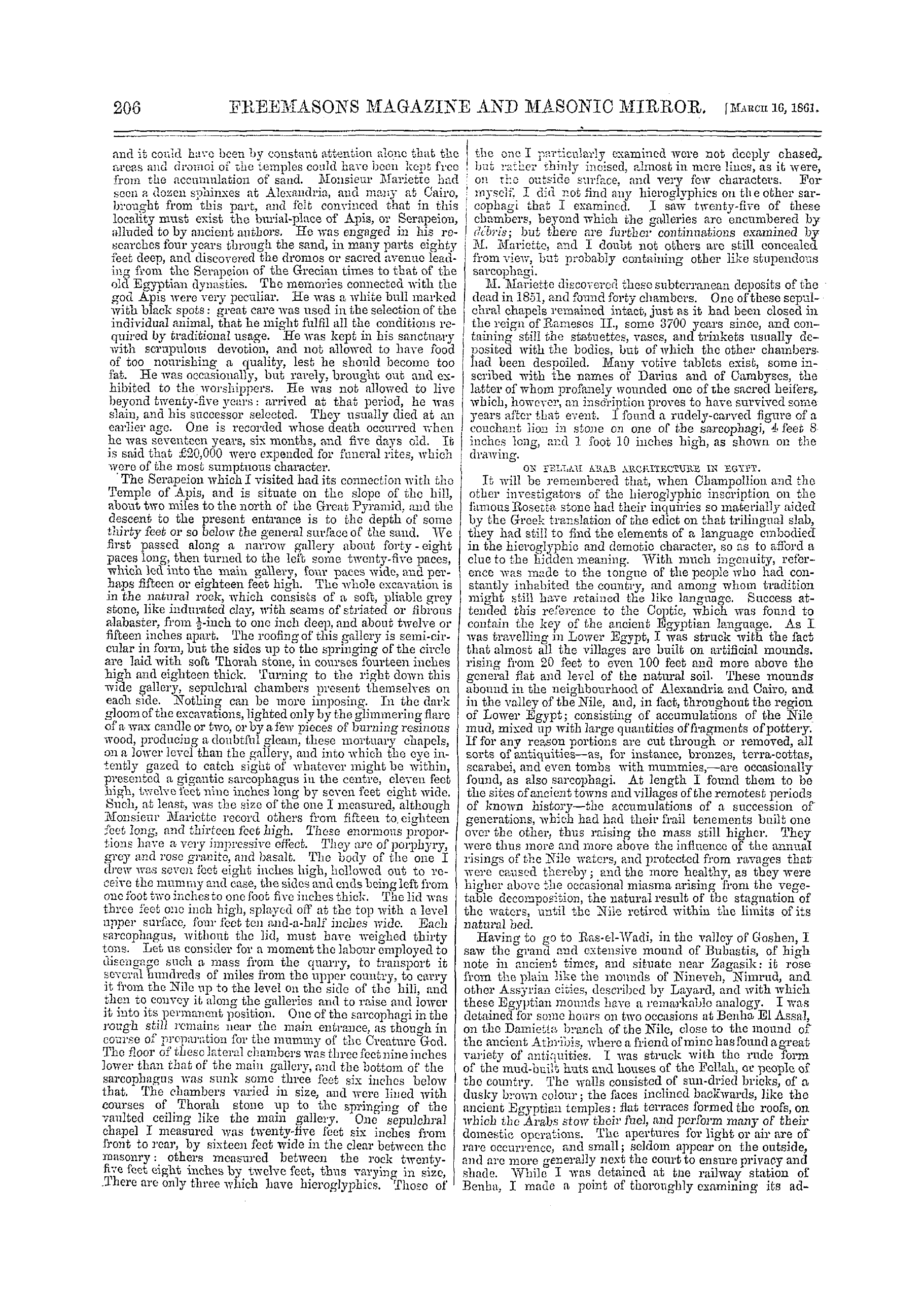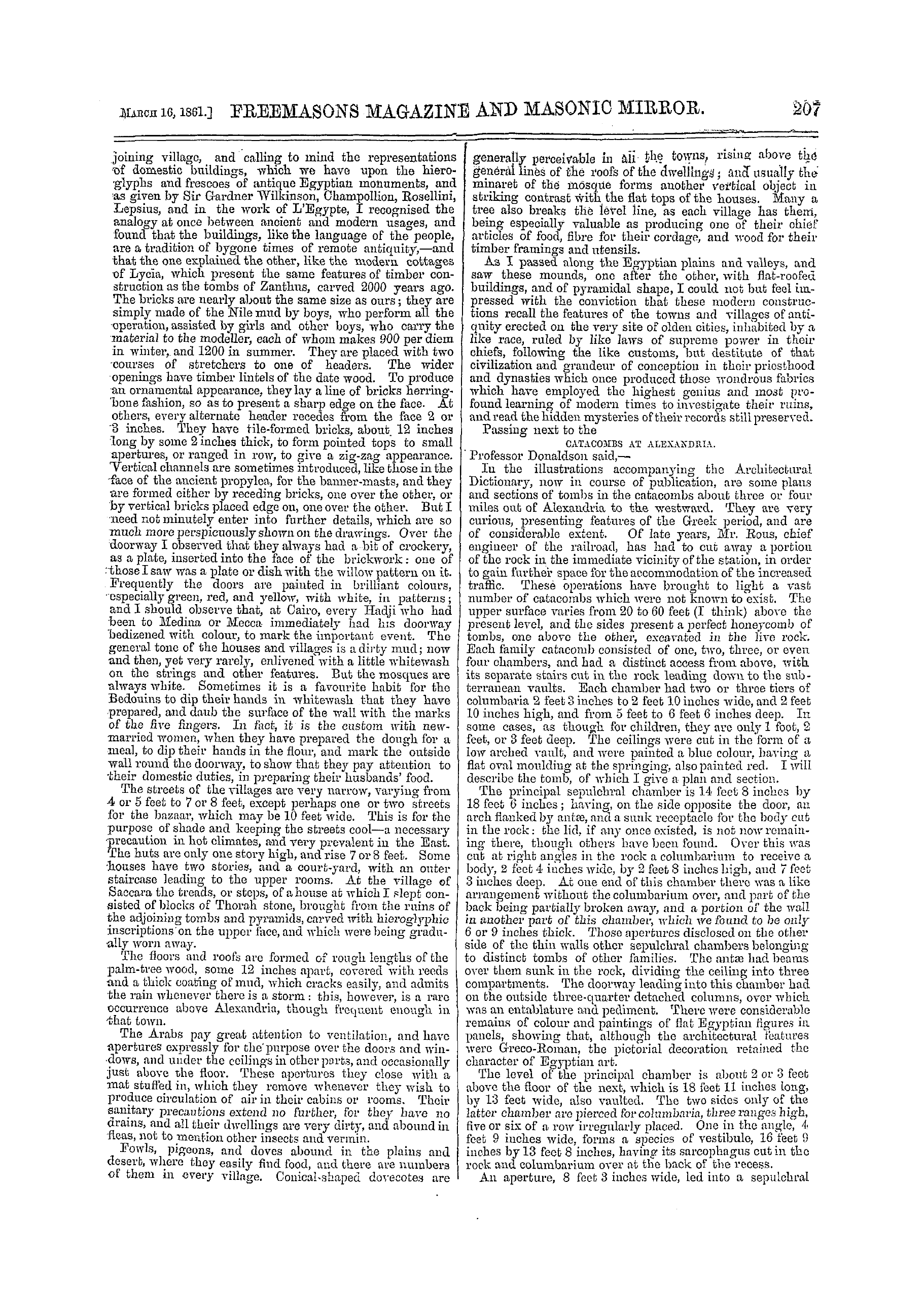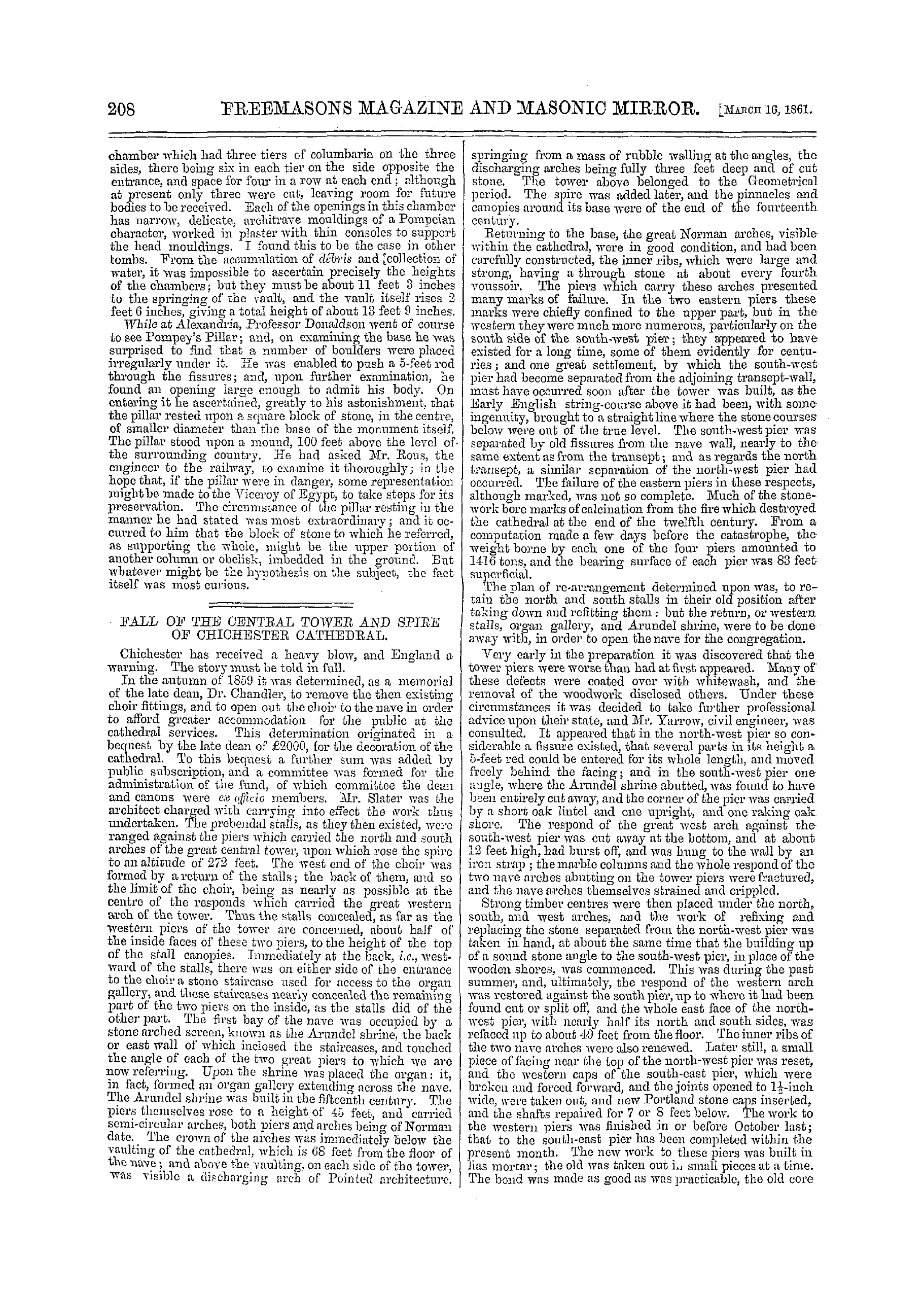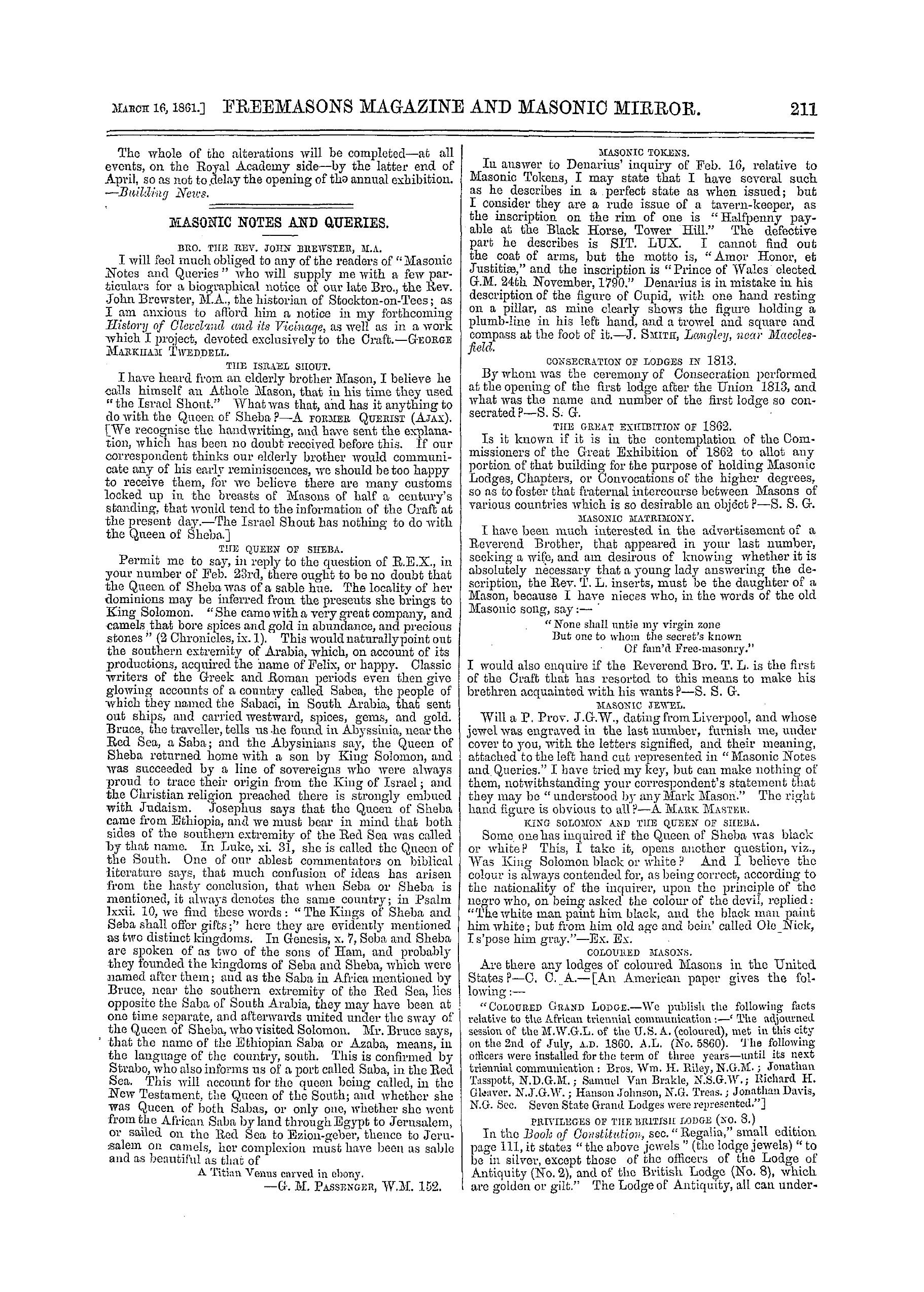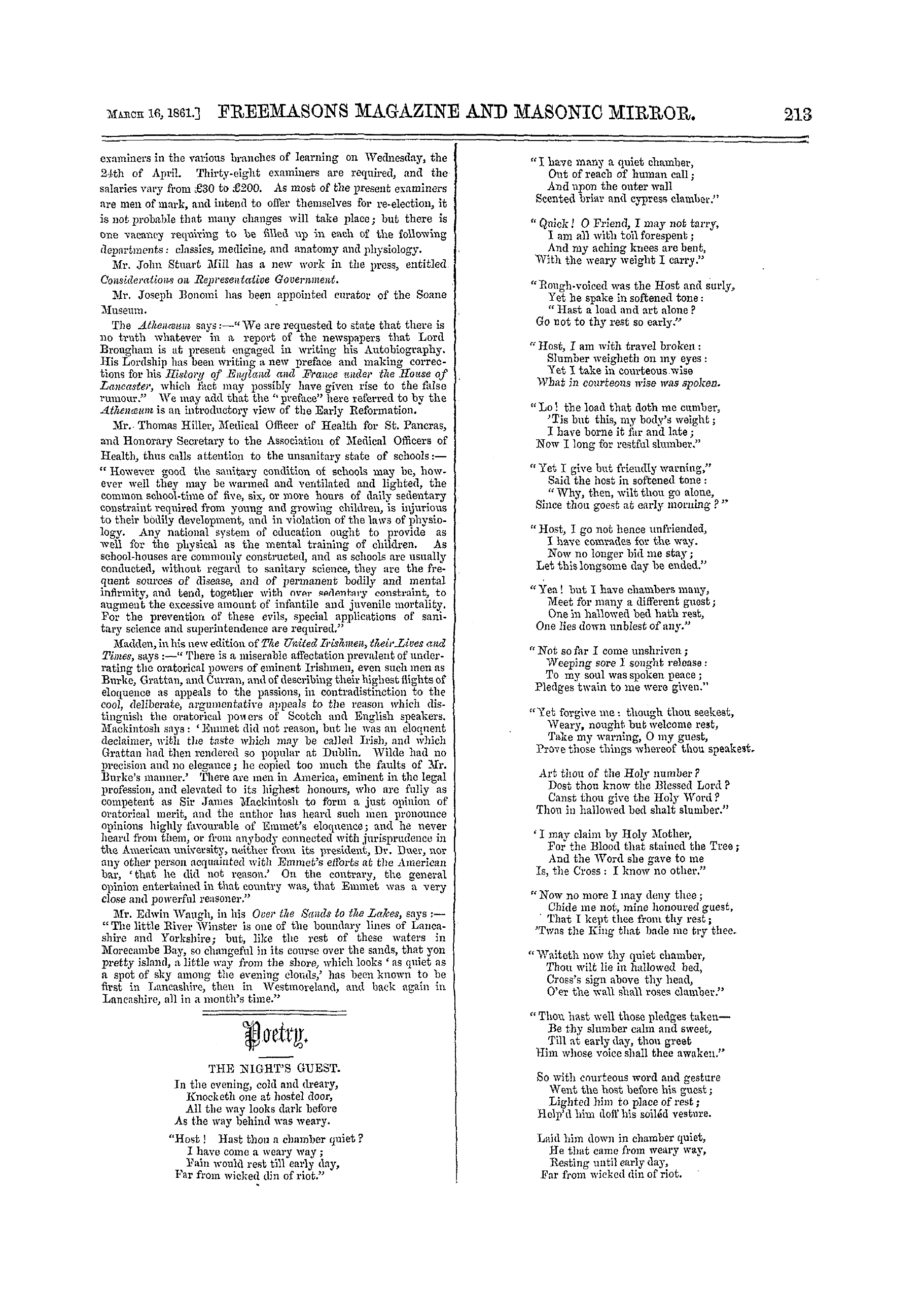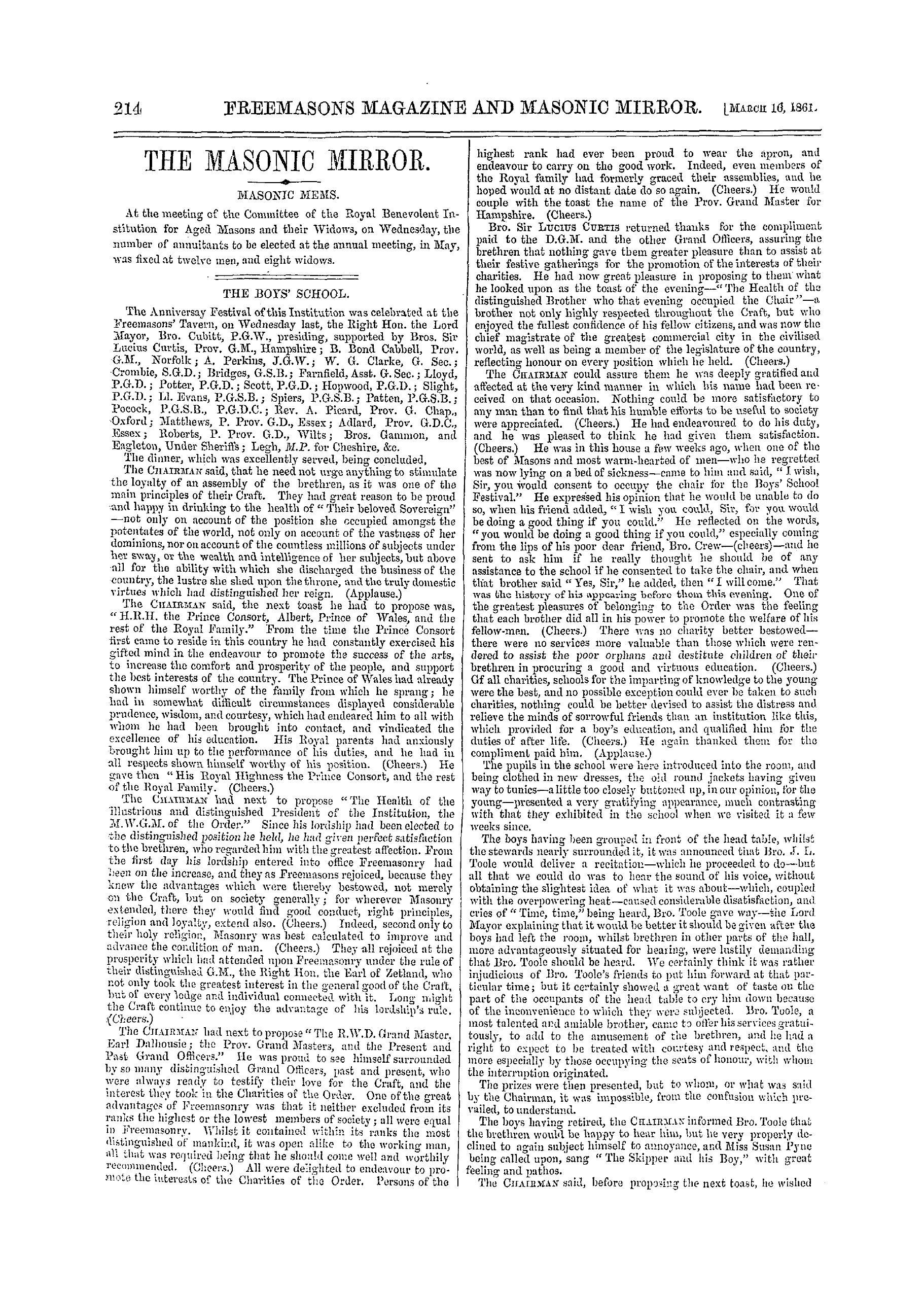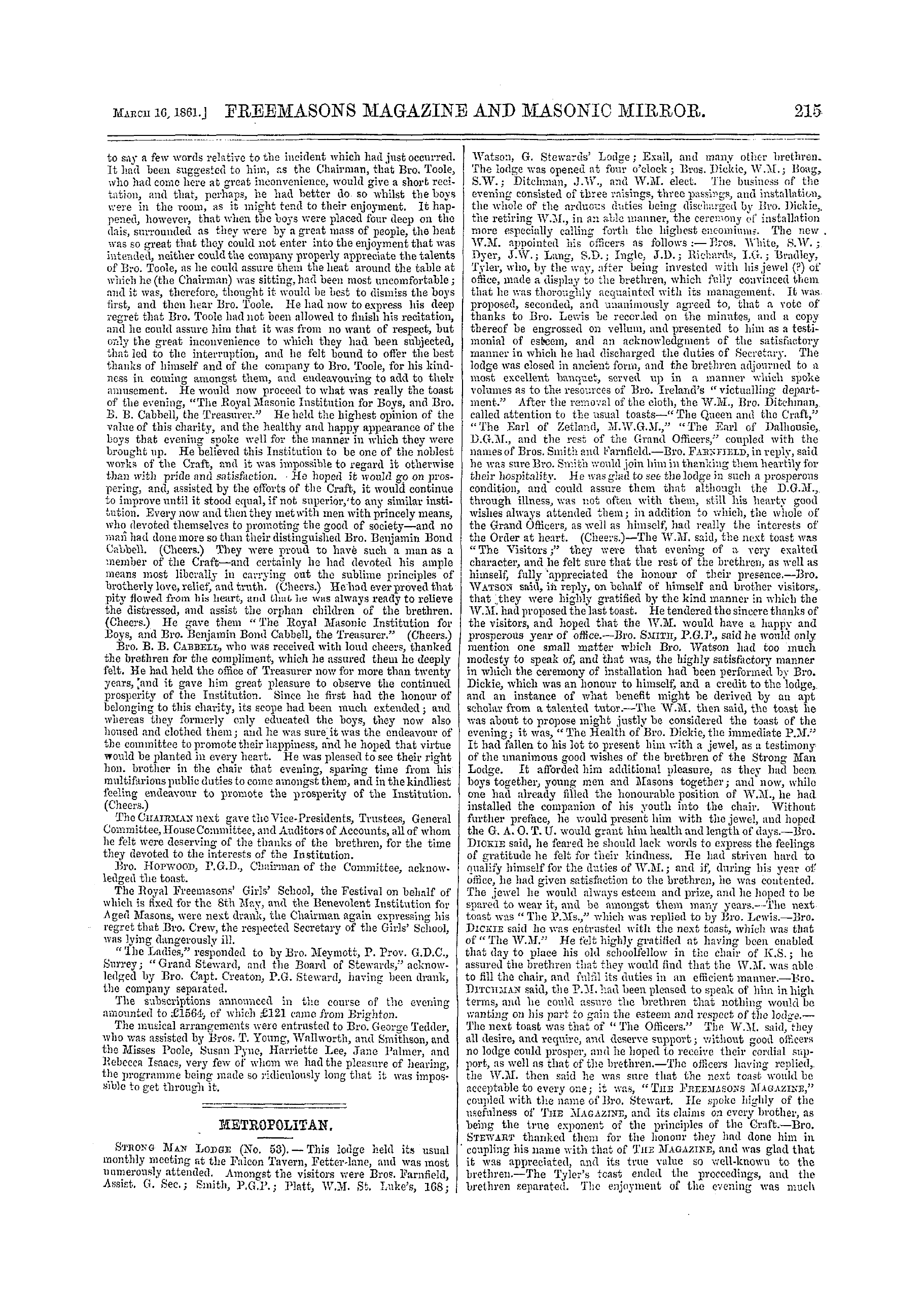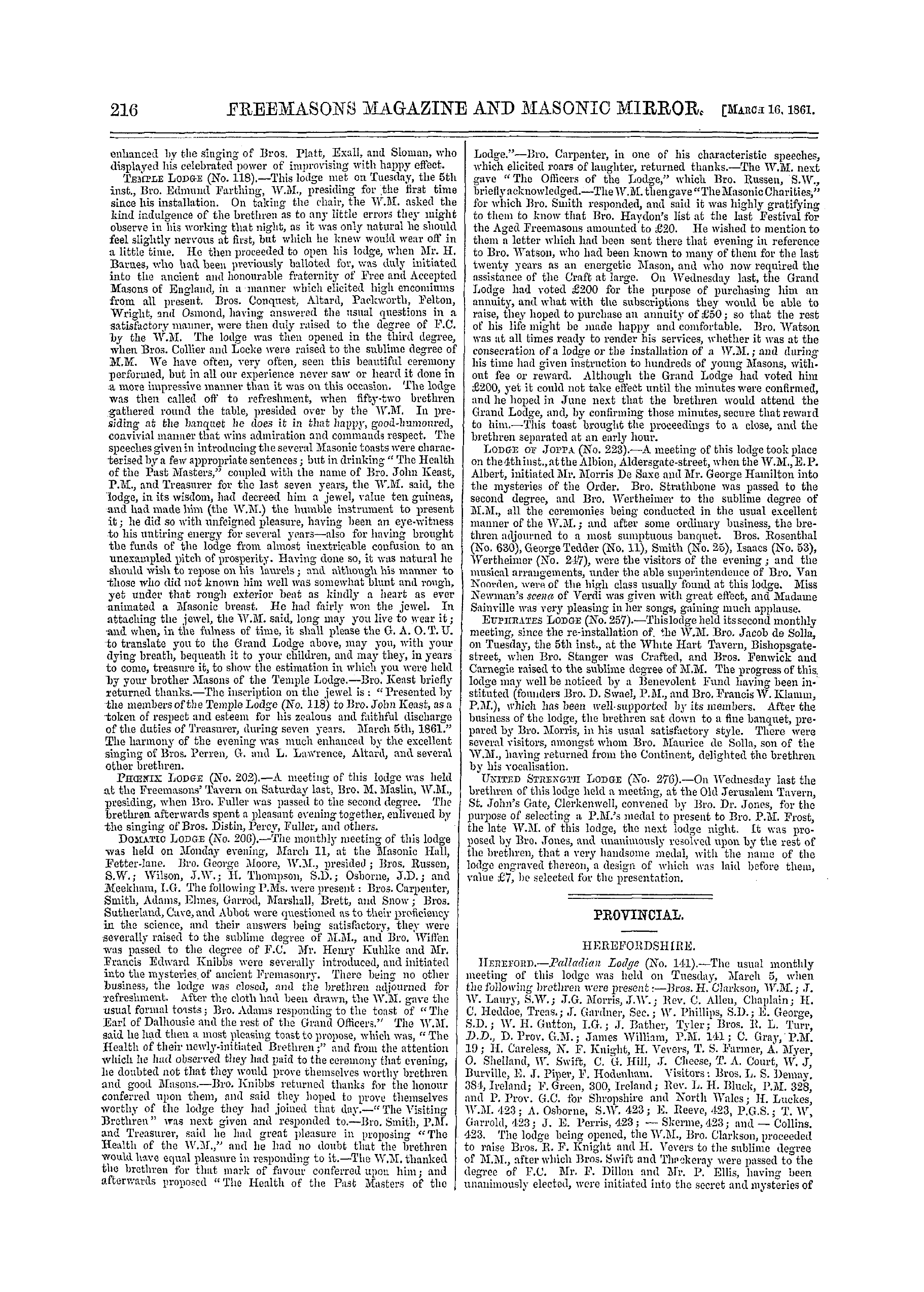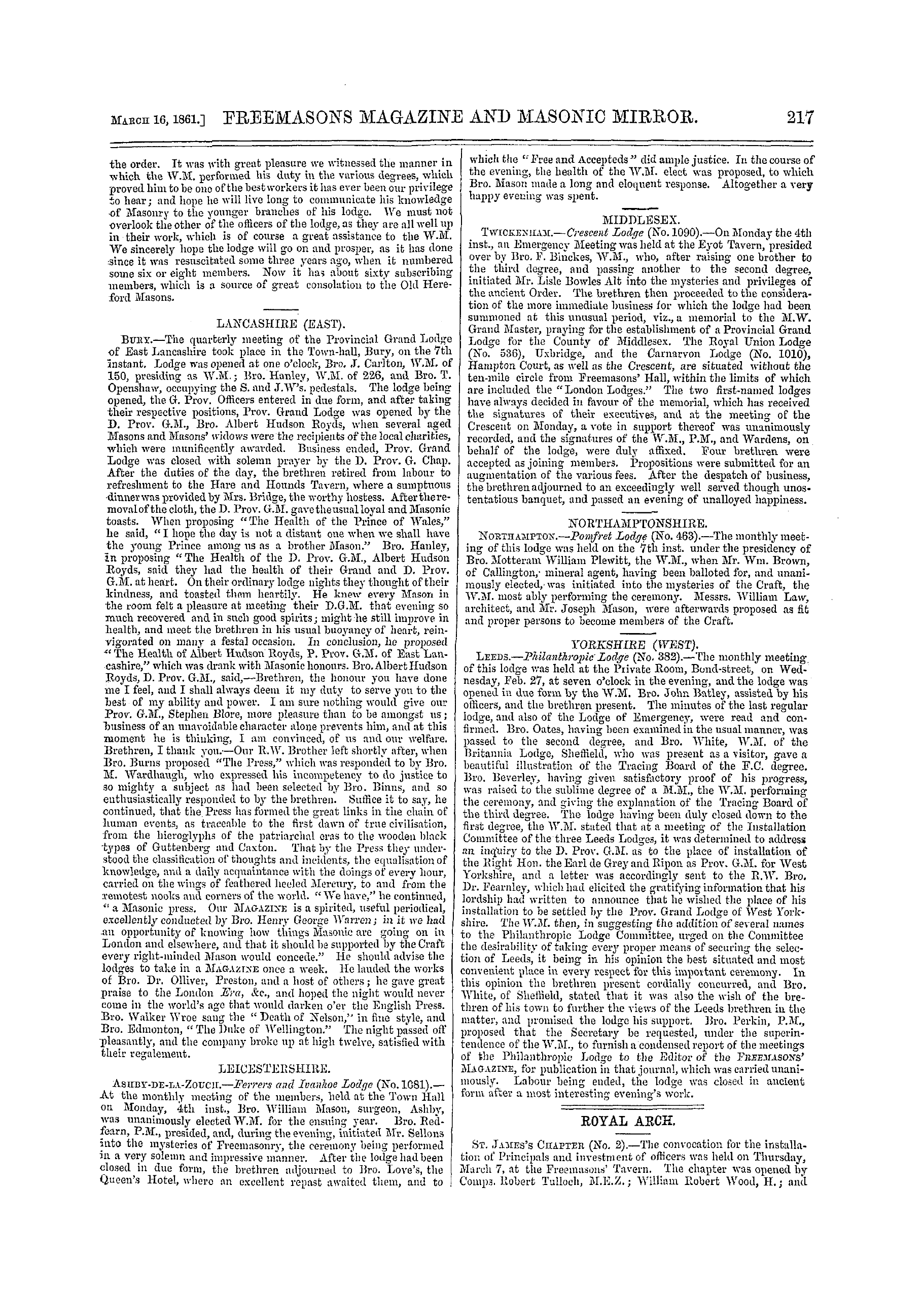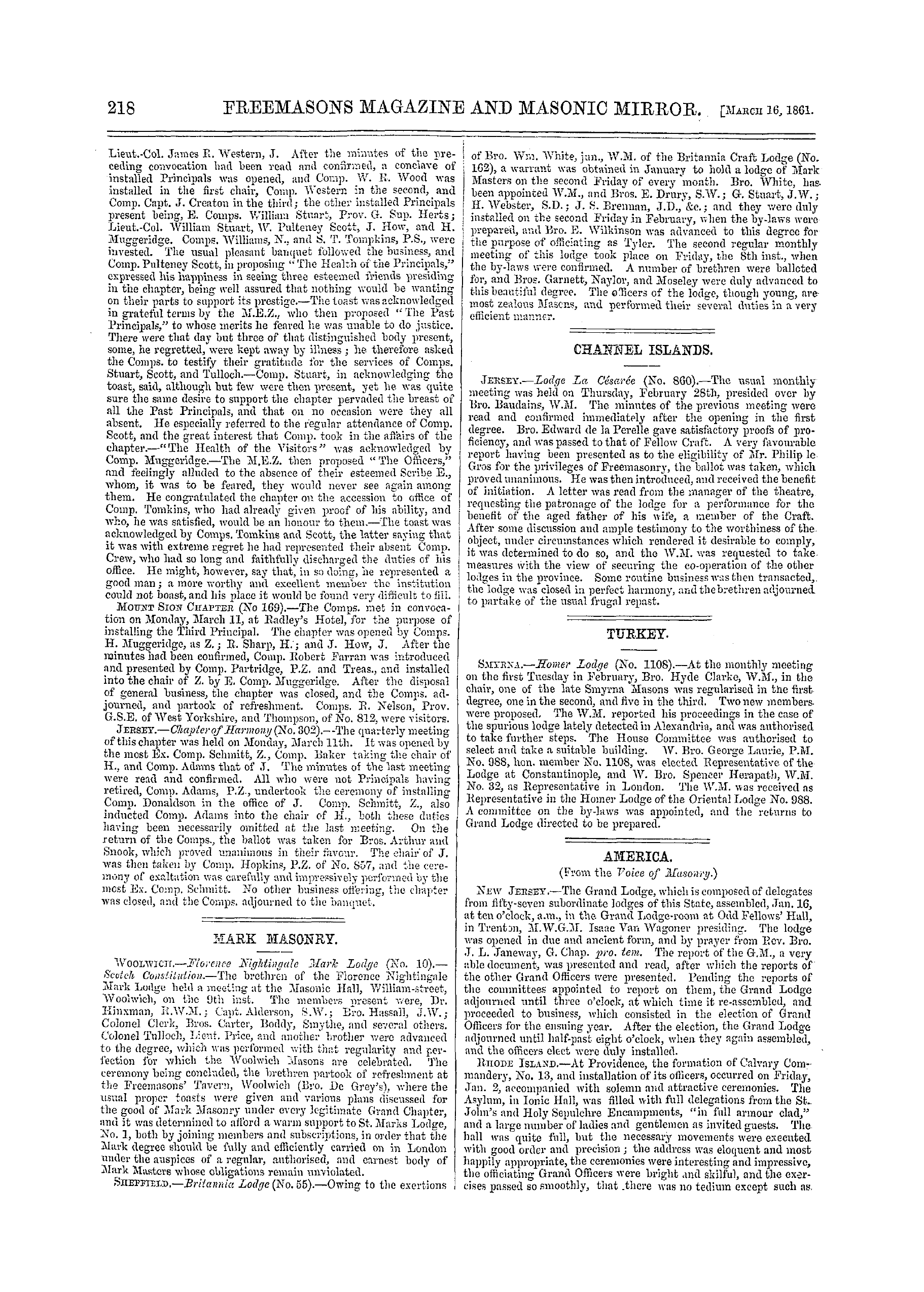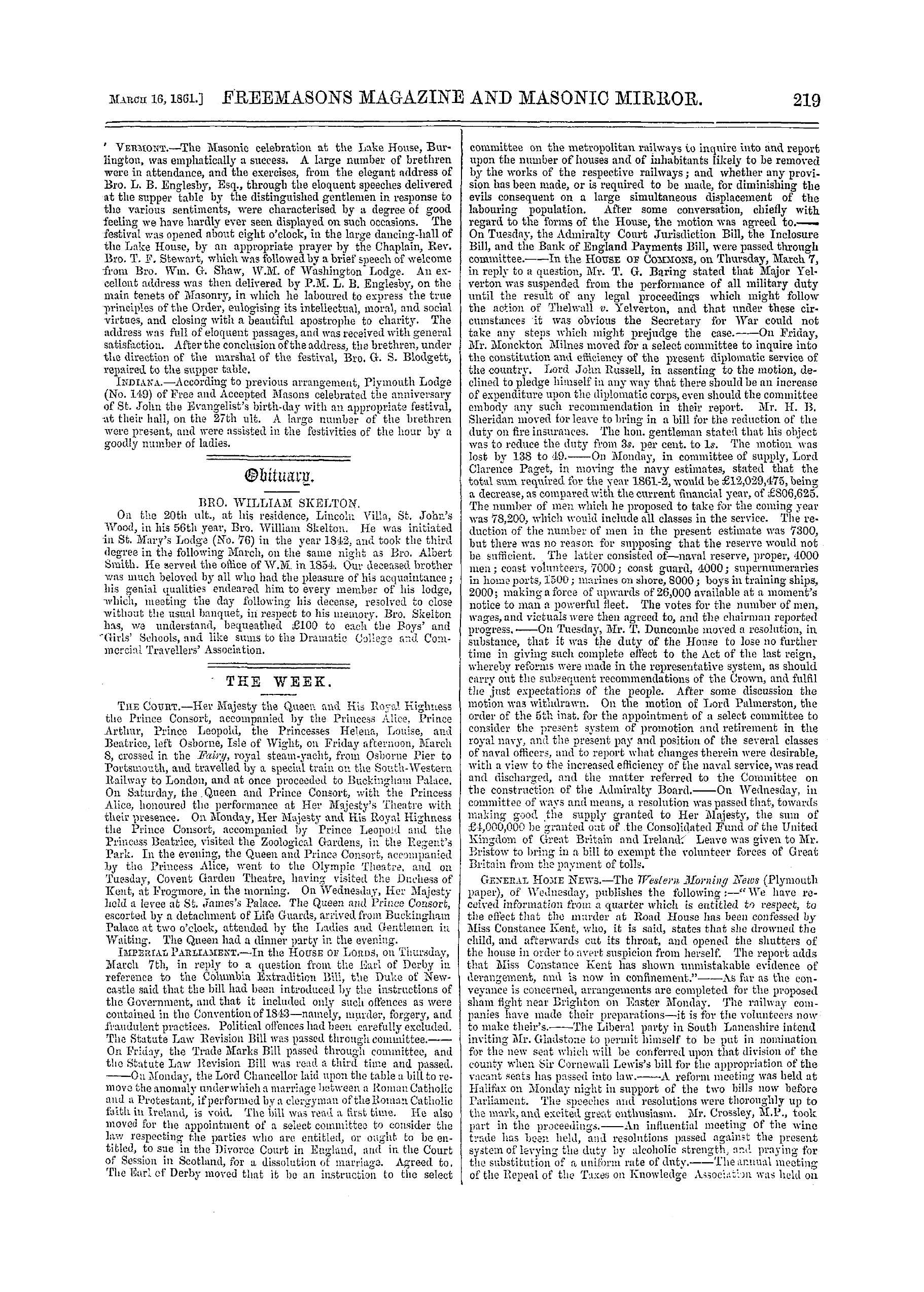-
Articles/Ads
Article SOME OBSERVATIONS IN EGYPT. ← Page 3 of 4 →
Note: This text has been automatically extracted via Optical Character Recognition (OCR) software.
Some Observations In Egypt.
joining village , and calling to mmd the representations ¦ of domestic buildings , which we have upon the hierogl yphs and frescoes of antique Egyptian monuments , and ¦ as given by Sir Gardner "Wilkinson , Champollion , Bosellini , Lepsius , and in the work of L'Egypte , I recognised the analogy at once between ancient and modern usages , and found that the buildings , like the language of the people ,
are a tradition of bygone times of remote antiquity , —and that the one explained the other , like the modem cottages of Lycia , which present the same features of timber construction as the tombs of Zanthus , carved 2000 years ago . The bricks are nearly about the same size as ours ; they are simply made of the Nile mud by boys , who perform all the operationassisted birls and other boyswho the
, y g , carry matez-ial to the modeller , each of whom makes 900 per diem in winter ,- and 1200 in summer . They are placed with two -courses of stretchers to one of headers . The wider ¦ openings have timber lintels of the date wood . To produce an ornamental appearance , they lay aline of bricks herringbone fashion , so as to present a sharp edge on the face . At others , every alternate header recedes from the face 2 or
" 3 inches . They have tile-formed bricks , about 12 inches long by some 2 inches thick , to form pointed tops to small apertures , or ranged in row , to give a zig-zag appearance . Vertical channels are sometimes introduced , like those in the -face of the ancient propylca , for the banner-masts , and they are formed either by receding bricks , one over the other , or by vertical bricks laced edonone over the otherBut I
p ge , . need not minutely enter into further details , which are so much more perspicuously shown on the drawings . Over the doorway I observed that they always had a bit of crockery , as a plate , inserted into the face of the brickwork : one of : those I saw was a plate or dish with the willow pattern on it . Frequently the doors are painted in brilliant colours ,
especially green , red , and yellow , with white , in patterns ; and I should observe that , at Cairo , every Hadji who had been to Medina or Mecca immediately had his doorway bedizened with colour , to mark the important event . The general tone of the bouses and villages is a dirty mud ; now and then , yet very rarely , enlivened " with a little whitewash on the strings and other features . But the mosques are always white . Sometimes it is a favourite habit for the
Bedouins to dip their hands in whitewash that they have prepared , and daub the surface of the wall with the marks ofthe five fingers . In fact , it is the custom with newmarried women , when they have prepared the dough for a meal , to dip their hands in the flour , and mark the ' ' outside wall round tbe doorway , to show that they pay attention to their domestic duties , in preparing their husbands' food .
The streets of the villages are very narrow , varying from 4 or 5 feet to 7 or 8 feet , except perhaps one or two streets for the bazaar , whieh may be 10 feet wide . This is for the purpose of shade and keeping the streets cool—a necessary precaution in hot climates , and very jirevaient in the East . The huts are only one story high , and rise 7 or 8 feet . Some -houses have two storiesand a court-yardwith an outer
, , staircase leading to the upper rooms . At the village of Saccara the treads , or steps , of a house at which I slept consisted of blocks of Thorah stone , brought from the ruins of the adjoining tombs and pyramids , carved with hieroglyphic inscriptions on the upper face , and which were being gradually worn away . The floors and roofs are formed of h lengths of the
roug palm-tree wood , some 12 inches apart , covered with reeds and a thick coating of mud , which cracks easily , and admits the rain whenever there is a storm . this , however , is a rare occurrence above Alexandria , though frequent enough in that town .
The Arabs pay great attention to ventilation , and have apertures expressly for the" purpose over the doors and windows , and under the ceilings in other ports , and occasionally just above the floor . Theso apertures they close with a mat stuffed in , which they remove whenever they wish to produce circulation of air in their cabins or rooms . Their sanitary jireeautions extend furtherfor they h
no , ave no drains , and all their dwellings are very dirty , and abound in fleas , not to -mention other insects and vermin . Fowls , pigeons , and doves abound in the plains and desert , where they easily find food , and there are numbers of them in every village . Conical-shaped dovecotes are
generally perceivable in ail ib ? towns , rising above the general lines of the roofs of the dwellings '; an J usually the minaret of the mosque forms another vertical object in striking contrast with the flat tops of the houses . Many a tree also breaks the level line , as each village has them , being especially valuable as producing one of their chief articles of foodfibre for their cordageand wood for their
, , timber framings and utensils . As I passed along the Egyptian plains and valleys , and saw these mounds , one after the other , with flat-roofed buildings , and of pyramidal shape , I could not but feel impressed with the conviction that these modern constructions recall the features of tbe towns and villages of antiquity erected ou the very site of olden cities , inhabited by a
like race , ruled by like laws of supreme power in their chiefs , following the like customs , but destitute of that civilization and grandeur of conception in their priesthood and dynasties which once produced those wondrous fabrics which have employed tho highest genius and most profound learning of modern times to investigate their ruins , aud read the hidden mysteries of their records still preserved . Passing uext to the
OATACOllBS AI ALEXANDRIA . ' Professor Donaldson said , — Iu the illustrations aceompairying the Architectural Dictionary , now in course of publication , are some plans and sections of tombs hi the catacombs about three or four miles out of Alexandria to the westward . They are very curious , presenting features of the Greek period , and are of considerable extent . Of late Mr . Bouschief
years , , engineer of the railroad , has had to cut away a portion ofthe rock iu the immediate vicinity of the station , in order to gain further space for the accommodation of the increased traffic . These operations have brought to light a vast number of catacombs which were not known to exist . The upper surface varies from 20 to 60 feet ( I think ) above the present level , and the sides jiresent a perfect honeycomb of
tombs , one above the other , excavated in the live rock . Each family catacomb consisted of one , two , three , or even four chambers , and had a distinct access from above , ivith its separate stairs out in the rock leading down to the subterranean vaults . Each chamber had two or throe tiers of columbaria 2 feet 3 inches to 2 feet 10 inches wide , and 2 feet 10 inches hihand from 5 feet to 6 feet 6 inches deep . In
g , some cases , as though for children , they are only 1 foot , 2 feet , or 3 feet deep . The ceilings were cut in tho form of a low arched vault , and were painted a blue colour , having a flat oval moulding at the springing , also painted red . I will describe the tomb , of which I give a jilan and section . The principal sepulchral chamber is 14 feet 8 inches by 18 feet 6 inches ; having , on tbe side oiiposite the door , an
arch flanked by anta ., and a sunk receptacle for the body * cut in the rock : the lid , if any once existed , is not now remaining there , though others have been found . Over this was cub at right angles in the rock a columbarium to receive a body , 2 feet 4 inches wide , by 2 feet 8 inches high , and 7 feet 3 inches deep . At one end of this chamber there was a like arrangement without the columbarium over , and part of the back being partiallbroken and a 'lortion of the wall
y away , in another part of this chamber , ivhich ive found to he only 6 or 9 inches thick . Those apertures disclosed on the other side of tho thin walls other sepulchral chambers belonging to distinct tombs of other families . The anta . had beams over them sunk in the rock , dividing the ceiling into three compartments . Tbe doorway leading into this chamber had on the outside three-quarter detached columns , over which
was an entablature and pediment . There were considerable remains of colour and paintings of flat Egyptian figures in panels , showbig that , although the architectural features wero Greco-Eoman , the pictorial decoration retained the character of Egyptian art . The level of the principal chamber is about 2 or 3 feet above the floor of the nextwhich is 18 feet 11 inches long
, , by 13 feet wide , also vaulted . The two sides only of the latter chamber are jfierced for columbaria , three ranges high , five or six of a row irregularly placed . One in the angle , 4 feet 9 inches wide , forms a species of vestibule , 16 feet 9 inches by 13 feet 8 inches , having its sarcophagus cut in thc rock and columbarium over at tbe back of the recess . An aperture , 8 feet 3 inches wide , led into a sepulchral
Note: This text has been automatically extracted via Optical Character Recognition (OCR) software.
Some Observations In Egypt.
joining village , and calling to mmd the representations ¦ of domestic buildings , which we have upon the hierogl yphs and frescoes of antique Egyptian monuments , and ¦ as given by Sir Gardner "Wilkinson , Champollion , Bosellini , Lepsius , and in the work of L'Egypte , I recognised the analogy at once between ancient and modern usages , and found that the buildings , like the language of the people ,
are a tradition of bygone times of remote antiquity , —and that the one explained the other , like the modem cottages of Lycia , which present the same features of timber construction as the tombs of Zanthus , carved 2000 years ago . The bricks are nearly about the same size as ours ; they are simply made of the Nile mud by boys , who perform all the operationassisted birls and other boyswho the
, y g , carry matez-ial to the modeller , each of whom makes 900 per diem in winter ,- and 1200 in summer . They are placed with two -courses of stretchers to one of headers . The wider ¦ openings have timber lintels of the date wood . To produce an ornamental appearance , they lay aline of bricks herringbone fashion , so as to present a sharp edge on the face . At others , every alternate header recedes from the face 2 or
" 3 inches . They have tile-formed bricks , about 12 inches long by some 2 inches thick , to form pointed tops to small apertures , or ranged in row , to give a zig-zag appearance . Vertical channels are sometimes introduced , like those in the -face of the ancient propylca , for the banner-masts , and they are formed either by receding bricks , one over the other , or by vertical bricks laced edonone over the otherBut I
p ge , . need not minutely enter into further details , which are so much more perspicuously shown on the drawings . Over the doorway I observed that they always had a bit of crockery , as a plate , inserted into the face of the brickwork : one of : those I saw was a plate or dish with the willow pattern on it . Frequently the doors are painted in brilliant colours ,
especially green , red , and yellow , with white , in patterns ; and I should observe that , at Cairo , every Hadji who had been to Medina or Mecca immediately had his doorway bedizened with colour , to mark the important event . The general tone of the bouses and villages is a dirty mud ; now and then , yet very rarely , enlivened " with a little whitewash on the strings and other features . But the mosques are always white . Sometimes it is a favourite habit for the
Bedouins to dip their hands in whitewash that they have prepared , and daub the surface of the wall with the marks ofthe five fingers . In fact , it is the custom with newmarried women , when they have prepared the dough for a meal , to dip their hands in the flour , and mark the ' ' outside wall round tbe doorway , to show that they pay attention to their domestic duties , in preparing their husbands' food .
The streets of the villages are very narrow , varying from 4 or 5 feet to 7 or 8 feet , except perhaps one or two streets for the bazaar , whieh may be 10 feet wide . This is for the purpose of shade and keeping the streets cool—a necessary precaution in hot climates , and very jirevaient in the East . The huts are only one story high , and rise 7 or 8 feet . Some -houses have two storiesand a court-yardwith an outer
, , staircase leading to the upper rooms . At the village of Saccara the treads , or steps , of a house at which I slept consisted of blocks of Thorah stone , brought from the ruins of the adjoining tombs and pyramids , carved with hieroglyphic inscriptions on the upper face , and which were being gradually worn away . The floors and roofs are formed of h lengths of the
roug palm-tree wood , some 12 inches apart , covered with reeds and a thick coating of mud , which cracks easily , and admits the rain whenever there is a storm . this , however , is a rare occurrence above Alexandria , though frequent enough in that town .
The Arabs pay great attention to ventilation , and have apertures expressly for the" purpose over the doors and windows , and under the ceilings in other ports , and occasionally just above the floor . Theso apertures they close with a mat stuffed in , which they remove whenever they wish to produce circulation of air in their cabins or rooms . Their sanitary jireeautions extend furtherfor they h
no , ave no drains , and all their dwellings are very dirty , and abound in fleas , not to -mention other insects and vermin . Fowls , pigeons , and doves abound in the plains and desert , where they easily find food , and there are numbers of them in every village . Conical-shaped dovecotes are
generally perceivable in ail ib ? towns , rising above the general lines of the roofs of the dwellings '; an J usually the minaret of the mosque forms another vertical object in striking contrast with the flat tops of the houses . Many a tree also breaks the level line , as each village has them , being especially valuable as producing one of their chief articles of foodfibre for their cordageand wood for their
, , timber framings and utensils . As I passed along the Egyptian plains and valleys , and saw these mounds , one after the other , with flat-roofed buildings , and of pyramidal shape , I could not but feel impressed with the conviction that these modern constructions recall the features of tbe towns and villages of antiquity erected ou the very site of olden cities , inhabited by a
like race , ruled by like laws of supreme power in their chiefs , following the like customs , but destitute of that civilization and grandeur of conception in their priesthood and dynasties which once produced those wondrous fabrics which have employed tho highest genius and most profound learning of modern times to investigate their ruins , aud read the hidden mysteries of their records still preserved . Passing uext to the
OATACOllBS AI ALEXANDRIA . ' Professor Donaldson said , — Iu the illustrations aceompairying the Architectural Dictionary , now in course of publication , are some plans and sections of tombs hi the catacombs about three or four miles out of Alexandria to the westward . They are very curious , presenting features of the Greek period , and are of considerable extent . Of late Mr . Bouschief
years , , engineer of the railroad , has had to cut away a portion ofthe rock iu the immediate vicinity of the station , in order to gain further space for the accommodation of the increased traffic . These operations have brought to light a vast number of catacombs which were not known to exist . The upper surface varies from 20 to 60 feet ( I think ) above the present level , and the sides jiresent a perfect honeycomb of
tombs , one above the other , excavated in the live rock . Each family catacomb consisted of one , two , three , or even four chambers , and had a distinct access from above , ivith its separate stairs out in the rock leading down to the subterranean vaults . Each chamber had two or throe tiers of columbaria 2 feet 3 inches to 2 feet 10 inches wide , and 2 feet 10 inches hihand from 5 feet to 6 feet 6 inches deep . In
g , some cases , as though for children , they are only 1 foot , 2 feet , or 3 feet deep . The ceilings were cut in tho form of a low arched vault , and were painted a blue colour , having a flat oval moulding at the springing , also painted red . I will describe the tomb , of which I give a jilan and section . The principal sepulchral chamber is 14 feet 8 inches by 18 feet 6 inches ; having , on tbe side oiiposite the door , an
arch flanked by anta ., and a sunk receptacle for the body * cut in the rock : the lid , if any once existed , is not now remaining there , though others have been found . Over this was cub at right angles in the rock a columbarium to receive a body , 2 feet 4 inches wide , by 2 feet 8 inches high , and 7 feet 3 inches deep . At one end of this chamber there was a like arrangement without the columbarium over , and part of the back being partiallbroken and a 'lortion of the wall
y away , in another part of this chamber , ivhich ive found to he only 6 or 9 inches thick . Those apertures disclosed on the other side of tho thin walls other sepulchral chambers belonging to distinct tombs of other families . The anta . had beams over them sunk in the rock , dividing the ceiling into three compartments . Tbe doorway leading into this chamber had on the outside three-quarter detached columns , over which
was an entablature and pediment . There were considerable remains of colour and paintings of flat Egyptian figures in panels , showbig that , although the architectural features wero Greco-Eoman , the pictorial decoration retained the character of Egyptian art . The level of the principal chamber is about 2 or 3 feet above the floor of the nextwhich is 18 feet 11 inches long
, , by 13 feet wide , also vaulted . The two sides only of the latter chamber are jfierced for columbaria , three ranges high , five or six of a row irregularly placed . One in the angle , 4 feet 9 inches wide , forms a species of vestibule , 16 feet 9 inches by 13 feet 8 inches , having its sarcophagus cut in thc rock and columbarium over at tbe back of the recess . An aperture , 8 feet 3 inches wide , led into a sepulchral
